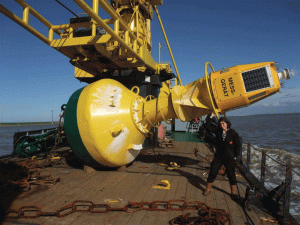A recent study (Barlow et al., 2023) on pygmy blue whale vocalisations in the South Taranaki Bight finds that their behaviour is influenced by environmental conditions, advancing our understanding of a genetically distinct population of blue whales considered data deficient by the New Zealand Department Of Conservation (DOC) .
Year round residents
The New Zealand pygmy blue whale population is present year-round in the South Taranaki Bight, making them ideal for acoustic studies such as this where recorders are deployed long-term in one location. Barlow et al. (2023) deployed five hydrophones in the South Taranaki Bight between January 2016 and February 2018.
Blue whales produce two call types, song and D calls. Song is thought to be used by males only and is associated with communication, social interactions, and reproduction. D calls, on the other hand, are less well understood but are thought to be social calls often related to foraging. They are produced by males and females of all ages. By analysing these vocalisations, researchers are able to gain valuable insight into blue whale presence and behaviour throughout the year.
Strong seasonality in call behaviour
Based on the patterns and intensity of their calls and song, there was strong seasonality in foraging and breeding behaviour, with song vocalisations peaking in the fall, indicating breeding behaviour.
Environmental factors, such as a marine heatwave, were found to impact the vocalisations and behaviour of the whales. Throughout the marine heatwaves, there was a decline in feeding-related calls, indicating poor foraging conditions. This was followed by a subsequent drop in vocalisations during the next breeding period, suggesting that reproductive efforts were potentially reduced as a result of poor foraging conditions.
During periods of upwelling, where deeper, cooler water forced towards the surface results in nutrient-rich water and aggregations of krill, the whales D calls were more intense indicating a correlation between activity and oceanographic conditions.
What this means for conservation
By understanding the ecology and response of these genetically distinct blue whales to changing environmental conditions, conservation efforts can be better tailored to protect their habitat. The study highlights the importance of continued monitoring to assess the impacts of changing ocean conditions and human activities on New Zealand blue whales.
Barlow, D., Klinck, H., Ponirakis, D., Branch, T., and Torres, L. (2023): Environmental conditions and marine heatwaves influence blue whale foraging and reproductive effort. Ecology and Evolution 13.



